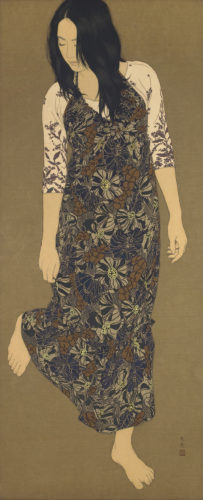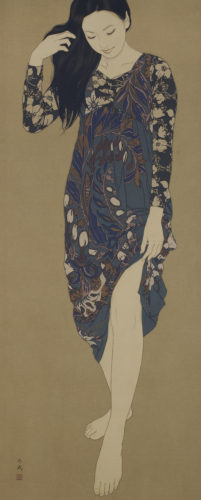Composition- the distance between artist and model
Morimoto: Most of your works focuses on the face or the chest, the composition is very impressive. It was like “wow” the first time I ever saw your work.
Ikenaga: In fact, I do draw from head to toe when I sketch. I then paint on several pieces of linen cloth in order to decide the proportion that I want.
Morimoto: That sounds like so much work! It couldn’t be done if you choose to paint on silk. The women that you paint are much or less southeastern asian style, exotic and gorgeous.
Ikenaga: Do you want to depict a beautiful woman or to convey the eroticism?
Morimoto: I like the woman portraits of Uemura Shoen and Kaburaki Kiyokata. Indeed, I want to paint beautiful figures in a sophisticated way.
Ikenaga: I have never wanted to convey anything through the action of painting. For me, painting is like making love.
Morimoto: Ooh, that’s definitely curious! (smile)
Ikenaga: We do not really demonstrate anything while making love. It’s an action of confirming of how deep we can embrace the one we loved. However, sex, it is finished when it is done, but by using the paintbrush I can still caress the body of my beloved for days.
Morimoto: I also have the feeling of caressing. I am with you, as a painter (smile).
Ikenaga: When it is still a full-length portrait in the sketch, I feel that I can’t even reach the person with my fingers. But as I zoom in, the horizon becomes narrow sort of like when we have sex. And that makes the final composition.
Morimoto: In that point, you have gone much far than I do. The women in my paintings probably are the ones that men want to hit on, yet hard to reach.
Ikenaga: I see. You put a certain distance between the audience and what they are watching. It sounds to me, close to the sensation of “first love.”
Morimoto: You got it! Even me, I could not go into the painting.
Ikenaga: I can’t really get the whole picture because I always lean forward as I paint. All I really do is to focus on a range of square centimeters, and if it goes well, all are good. I would repeat the process several times until it’s done.
Morimoto: It is hard for me to do that (smile). I would repeat the process of seeing the painting from a distance then come closer to paint. Somehow, at a certain moment, the painting itself would start to tell me how to paint, such as it should be red over here. It is the painting that takes the lead and normally the outcome is good.

Layering the paint over and over again in order to mimic skin texture
Morimoto: Basically, when I see a work, I care more about the color than the form. So I pay so much attention on the color. For instance, in order to achieve the skin color that I want, I would put several thin layers of light color, probably more than dozen times.
Ikenaga: Same here. As I add the layers, gradually the color of the pigment turns into other color. I find, the skin color is so vivid that the woman becomes a real person.
Morimoto: Yes, you can say that again.
Ikenaga: But it is difficult to get the right tone every single time.
Morimoto: Yeah, it depends on the way you mix the pigment, weather, moisture and also the way you paint.
Ikenaga: I’ve kept this as a secret. In fact, I use digital scale to weigh the pigments and glue. Every time I get different numbers. I think that for a craftsman, it is necessary to do some adjustment to accomplish the same result. I also would love to have a successful recipe because it is almost there if I can create the right skin tone.
Morimoto: That’s certainly right.
Ikenaga: Um, but starting with a thick layer of pigment and then gradually adjusting it could wok fine as well.
Morimoto: But moisture begins to vaporize once on the canvas, every stroke is very important. One mistake will possibly ruin the whole painting. You use mineral pigments to paint on the canvas, don’t you? That’s impressive!
Ikenaga: First, I dye the linen cloth brown. Then when I paint a layer of light skin color, the paint will drip down through mesh so that the brown part stays on the surface of the canvas. I want to create a texture of tapestry or weaving cloth.
Morimoto: That’s clear as we can see. It’s similar with silk, the paint will drip down.

Bijin-ga of our time
Morimoto: In the past, we had so many bijin-ga (Portraits/ prints of beautiful women), nowadays there are fewer and fewer people who draw human portraits in Japanese-style painting genre.
Ikenaga: The reasonI started to paint human portraits was because I wanted to draw someone I loved. I hated those classic portraits of beautiful women in some periods but I think it’s time for us to resume the tradition.
Morimoto: Do you think that your works are “bijin-ga” ?
Ikenaga: That’s not my intention but i would rather be happy if someone calls them so. By the way, do you paint nude portraits?
Morimoto: It is really difficult for me. I don’t think I could bring out the femininity if I draw nude portraits. After all, I look up to those painters like Shoen and Kiyokata.
Ikenaga: I want to paint nude portraits- my lover’s dead body at my last moments.
Morimoto: That must be your ultimate vision of bijin-ga! Ikenaga: It is so easy to fall in love with the women you create. You can’t find the same sensation in my paintings.
Morimoto: No, no, I have the same sensation about your works as well. But, you are right, I do expect people will have a crush on the women in my works. Not really love but crush, you know, the feeling that you just could not let go.
Ikenaga: My works are done after some “embarrassing” moments. I don’t really care how people look at them.
Morimoto: That’s probably the biggest difference between us. I really take that into consideration, I mean how I would like people to feel, thus I make some stories in my paintings. for example, they may feel sad or think that the wind looks so nice, etc. It is alike when I draw flowers. A bold red flower represents a strong attraction, on the other hand, a light pink flower brings about an image of a pitiful plant blossoms quietly in the shade.
Ikenaga: Bijin-ga has deeply marked the last generation of Japanese-style painting. And, it is no surprise to stir a sense of aversion for people of our times. I have been told several times that, “It’s too late! what are you going to do after all these years?” But I would love to tell those art students who feel perplexed and don’t know what to do, “It’s ok, we can start again, you have Morimoto Jun and me in the same boat.”
28th March 2011